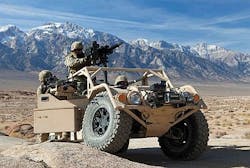Blog: These are tough times for the combat vehicle and vetronics industries
U.S. forces are wrapping up their withdrawal from Iraq, and the military draw down from Afghanistan is far along. Fleets of main battle tanks, armored personnel carriers, armored humvees, and self-propelled artillery have begun to sit idle, with little prospect for their continued operation anytime soon.
With this growing surplus of armored combat vehicles, demand for new vehicles and retrofits is at its lowest point in years. Sure, the industry is trying to put a good face on it with well-publicized programs for a new Ground Combat Vehicle (GCV) and new Joint Light Tactical Vehicle (JLTV), but where's the demand? More importantly, with the budgetary problems the U.S. government has these days, where's the money?
Military combat vehicle manufacturers like General Dynamics Land Systems in Sterling Heights, Mich., BAE Systems Land & Armaments in Arlington, Va., and Oshkosh Corp. in Oshkosh, Wis., are doing their best to keep themselves relevant amid these stark new realities.
These combat vehicle designers are building their latest models from the ground up to handle network-centric warfare, with built-in computer networking backbones to integrate surveillance, targeting, electronic warfare, and communications systems, and accommodate new technologies seamlessly in plug-and-play architectures.
These will be come of the world's most advanced and capable combat vehicles ever made. Just as important, today's combat vehicle manufacturers are designing vehicles to confront the most dire threats from insurgents and terrorists whose favorite weapon is the improvised explosive device (IED).
The V-shaped underbelly structures of the latest combat vehicles are designed to protect against IED explosions and other roadside booby-trap threats. Their suspensions enable soldiers inside to drink coffee in safety and comfort even while tearing over rugged off-road terrain at 40 miles per hour.
Despite all this, however, dwindling military budgets and growing fleets of idle combat vehicles bode ill for the immediate future of the combat vehicle and vetronics industries.
Many in the defense industry are coming around the realization that the era of the heavy-iron U.S. military might be over. In the future, those companies that can accommodate a fast, agile, and Special-Forces-centric military may be the big winners.
Those who don't may take their places in the graveyards of irrelevant technologies.
